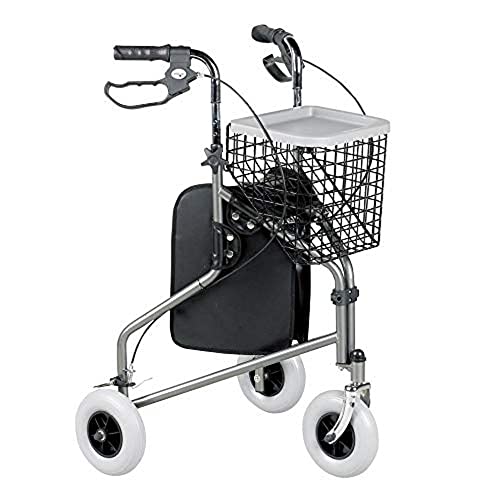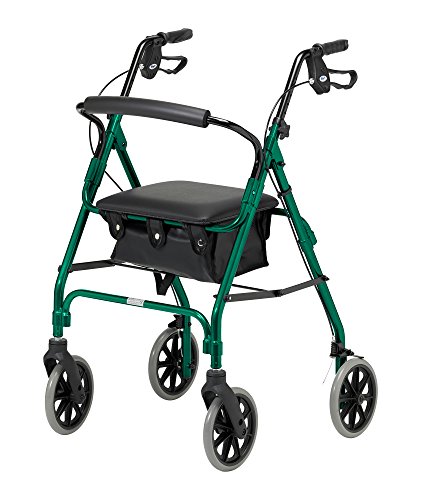See What Rollator Mobility Walker Tricks The Celebs Are Making Use Of
페이지 정보

본문
 rollator solution Mobility Walker
rollator solution Mobility WalkerRollators are an excellent choice for people with restricted mobility who require stability when walking. They have large wheels and space for seats built into their frames.
This model has padding on the handles to provide comfort and relieve pressure on your hands. It has height-adjustable handles and intuitive loop locks to prevent the walker from moving while you're resting or sitting.
Comfort
Whether someone has recently suffered an injury that impacts their gait and balance, or is recovering from knee, hip or other lower-limb surgeries, or injuries, a rollator mobility walker can help. These walking aids offer stability and support and allow users to move more comfortably and stay active with their family and friends, as well as with the community.
They are available in a variety of styles like the traditional walker with wheels that looks more plain than a walker that is rolling. They typically have handles that are placed at a height that is comfortable for the user, making them ideal for those who needs stable support but would like to be able move faster than with a cane.
The wheels on a rolling walker allow it to be more flexible and simple to use than a regular walking device. The wheels on a rollator are closer together so that it is easier to move and guide the device in tight spots. They can also be rotated to increase agility when climbing and descending stairs. Many rollators come with a seat and crossbar to provide a place for users to rest when they require.
Handles for rollators can be constructed from materials that vary in thickness and texture. The grips made of hard plastic can be a burden for those who suffers from arthritis So, look for soft and textured handles that are easy to hold. Consider whether the device has loop-lock breaks or brakes that are activated by lean to accommodate various hand sizes.
Stability
A good rollator should come with a comfortable and spacious seat that users can relax on when they want to relax. It should have brakes that are easy to operate and ergonomic, soft grips. These grips should be cushioned, and they should be comfortable for those with wrist or hand problems. Some models come with a cushioned backrest for added support. It is crucial to choose a walker with sufficient capacity for your weight, and one with adjustable handles to fit your height.
A locking mechanism for a walker is essential for people who travel frequently or require transporting the walker inside and out of their vehicle. It will help to prevent the walker from being accidentally opened while traveling, thereby preventing injuries and damages. Consider whether the walker is adaptable to your requirements with interchangeable and removable components.
Researchers conducted a study in order to determine how the task-performance strategy, and the device load affects rollator stability. The study involved ten people who performed six tasks using an instrumented rollator folding. The team measured the system's Stability Margin, which is the sum of centre pressure and the base support. The team discovered that SM decreased significantly when an individual was asked to do other tasks than straight line walking. They also discovered that leaning on the device may increase the force centre in the support for the base and can also increase or decrease stability. The authors conclude that these findings can be used to improve training for the safe use of rolling devices. They suggest that greater focus should be given to activities other than straight line walking and on the specific strategies for performance of each exercise, which may facilitate or impede stability.
Capacity for weight-bearing
A rollator walker is capable of supporting up to 300lbs, or more depending on the model. Its sturdy frame with four wheels can aid in maintaining the balance and mobility of people particularly with medical conditions or aging. Rollators are more maneuverable than standard walkers that require the user to lift their weight in order to move forward. This helps reduce hand fatigue.
Rollators have wheels that are usually 6 to 10 inches in width. This allows them to be used indoors and outdoors on different surfaces. Certain models have a variety of height settings to accommodate different users. Others fold for easy storage and transport. Some models come with a seating area that allows the user to rest while walking.
Many walkers come with a selection of accessories, like the walker basket, which can be used to store personal items or an eating tray to put food on while using the device. A wrist guard is provided to safeguard your hands from injury as well as bags for walker's to carry other items. Some walker frames are compatible with wheelchairs, making them easy to change when one's mobility requirements change.
A bariatric rolling device is designed with a strong frame and wider seat to safely support larger people. It features height-adjustable handles as well as a padded backrest that is wide as well as hand brakes that are locked to ensure the maximum security and safety. The angled handle bars position the hands in a neutral position to prevent stress and fatigue and its handy storage strap allows it to easily fit into a vehicle's trunk. The 8" wheels feature anti-tip technology for added stability and a greater maneuverability. The cushioned seat provides an ideal spot to rest on the move.
Brakes
A rollator works differently than a traditional walker. Instead of having all four legs touching the ground, a rollator comes with wheels that are controlled by hand brakes situated below or integrated into the handlebars. This design helps to make it easier for users to navigate tight spaces and make quick left and right turns. The brakes can become hard to operate or loose, which can be a risk to people with weaker muscles and diminished mobility.
Many manufacturers provide the option of adding brakes that can also be locked to improve safety and stability. This feature is particularly beneficial for people who have difficulty squeezing the brakes or applying pressure due to a weak grasp or other health issues such as arthritis. There are some variations in the way the locking brakes are set however most walkers use the same steps to ensure they are set correctly.
Before you attempt to adjust the brakes of your lock, it is recommended to read any maintenance instructions included with your mobility aid to find specific directions. To begin you must find the knob to adjust the brake or screw typically positioned near the handle grips, and tighten it by turning it clockwise. This is essential since if you do not tighten the adjuster in the correct way it will be impossible to eliminate the slack in the brake cable. After you have tightened the adjuster screw for brakes then move to the lower cable adjuster nut and tighten it using the same method. After you have finished these adjustments check your brakes by gently pressing the levers. If they don't then it is most likely that the locking mechanism has been damaged.
Accessories
There are a variety of accessories available for hybrid rollator walkers, including cups and baskets. Some are great for carrying things while walking and some such as the Mobility Phone Grip, clip onto the bars that are vertically attached to a walker or wheelchair and expand to hold smartphones. The grips can also swivel and adjust to the perfect height to hold the device. Many of these gadgets are designed to be light and easy to use, which makes them perfect for those suffering from arthritis or other hand injuries.
Most walker and rollator manufacturers offer a range of handle sizes, so you can choose the best one for your body type. Consider the weight capacity when choosing a collapsible rollator walker. This will affect the way it performs for you. While most rollators for seniors are designed to accommodate people up to 300 pounds, some manufacturers have bariatric models that can handle up to 500 pounds.
When selecting a walker, or rollator, you should be aware of the brakes you will use. Push down brakes stop forward motion by applying downward pressure to the frame. Loop brakes are similar, but they require simultaneous use of both hands and a bit more physical strength to apply. Both types of brakes are a vital safety feature, and it's important to find the best option for your needs.
See a doctor, a physical therapist or occupational therapist if unsure of which walker or rollercaster is best for you. They will be able to advise you on the features that are most beneficial for your particular situation, and will help you find the right model that is compatible with any other equipment you have at home or stored.

- 이전글The Next Big Thing In The SEO London Industry 24.09.17
- 다음글Levitra 10 mg nw713 24.09.17
댓글목록
등록된 댓글이 없습니다.

